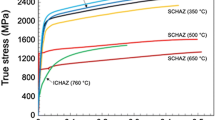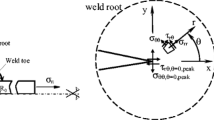Abstract
This paper aims to predict failure modes of spotwelded metals using an available failure criterion, namely, the ESI-Wilkins-Kamoulakos (EWK) rupture model, in the PAM-CRASH finite element (FE) commercial software. By accounting for the hydrostatic pressure and the stress asymmetry, the EWK model can successfully predict different failure modes in the welding strength tests, including the shear mode, which cannot be predicted by Gurson’s model. Moreover, characteristics of the spotweld, including residual stress, phase distributions, sizes and material roper ties of different zones, are obtained from an analysis with the SYSWELD software and are then mapped into the failure prediction model to achieve a realistic description of the weldment. Both the simulated results of the FE model combining solid and shell elements and those of the model with only solid elements show rather good consistency with the welding strength test data.
Similar content being viewed by others
References
Airoldi, A. and Cacchione, B. (2005). Numerical analyses of bird impact on aircraft structures undergoing large deformations and localised failures. M. Alves, N. Jones (Edn), Impact Loading of Lightweight Structures. WIT Trans. Engineering Sciences, Southampton, U.K.
Chang, B., Shi, Y. and Lu, L. (2001). Studies on the stress distribution and fatigue behavior of weld-bonded lap shear joints. J. Materials Processing Technology, 108, 307–313.
Chao, Y. J. (2002). Failure of spot weld: A competition between crack mechanics and plastic collapse to appear in recent advances in experimental mechanics in honor of professor I. M. Daniel. 14th US National Cong. Applied Mechanics, Virginia Tech., U.S.A.
Combescure, A., Delcroix, F., Caplain, L., Espanol, S. and Eliot, P. (2003). A finite element to simulate the failure of weld points on impact. Int. J. Impact Engineering, 28, 783–802.
Deng, X., Chen, W. and Shi, G. (2000). Three-dimensional finite element analysis of the mechanical behavior of spot welds. Finite Elements in Analysis and Design, 35, 17–39.
ESI-Group (2005). SYSWELD Reference Manual Version 2005. Cedex. Parais. France.
ESI-Group (2008). PAM-CRASH Solver Reference Manual and Solver Notes Manual Version 2008. Cedex. Parais. France.
Fan, X., Masters, I., Roy, R. and Williams, D. (2007). Simulation of distortion induced in assemblies by spot welding. Proc. Institution of Mechanical Engineers, Part B: J. Engineering Manufacture, 221, 1317–1326.
Goodman, L. E. and Keer, L. M. (1977). Near field stress analysis of a spot weld between elastic plates. Int. J. Solids and Structures, 13, 151–158.
Kamoulakos, A. (2004). The ESI-Wilkins-Kamoulakos (EWK) Rupture Model. Raabe, D., Roters, F., Barlat, F. and Chen, L.-Q. (Edn). Continuum Scale Simulation of Engineering Materials: Fundamentals — Microstructures — Process Applications. Wiley-VCH. Berlin. Germany. 795–804.
Khan, M. I., Kuntz, M. L. and Zhou, Y. (2008). Effects of weld microstructure on static and impact performance of resistance spot welded joints in advanced high strength steels. Science and Technology of Welding and Joining, 13, 294–304.
Kim, H. Y., Choi, J. G., Lee, K. W. and Yeo, T. J. (2008). Cumulative impact damage evaluation of automotive aluminum bumper beam. Int. J. Modern Physics B, 22, 1584–1591.
Langrand, B. and Markiewicz, E. (2010). Strain-rate dependence in spot welds: Non-linear behaviour and failure in pure and combined modes I/II. Int. J. Impact Engineering, 37, 792–805.
Lin, P. C., Lin, S. H. and Pan, J. (2006). Modeling of failure near spot welds in lap-shear specimens based on a plane stress rigid inclusion analysis. Engineering Fracture Mechanics, 73, 2229–2249.
Lin, S. H., Pan, J., Tyan, T. and Prasad, P. (2003). A general failure criterion for spot welds under combined loading conditions. Int. J. Solids and Structures, 40, 5539–5564.
Mikno, Z. (2005). Some problems associated with the control of the resistance spot welding process. Welding Int., 19, 845–849.
Nielsen, K. (2008). 3D modelling of plug failure in resistance spot welded shear-lab specimens (DP600-steel). Int. J. Fracture, 153, 125–139.
Pickett, A. K., Pyttel, T., Payen, F., Lauro, F., Petrinic, N., Werner, H. and Christlein, J. (2004). Failure prediction for advanced crashworthiness of transportation vehicles. Int. J. Impact Engineering, 30, 853–872.
Pouranvari, M., Asgari, H. R., Mosavizadch, S. M., Marashi, P. H. and Goodarzi, M. (2007). Effect of weld nugget size on overload failure mode of resistance spot welds. Science and Technology of Welding & Joining, 12, 217–225.
Song, J. H., Huh, H., Kim, H. G. and Park, S. H. (2006). Evaluation of the finite element modeling of a spot welded region for crash analysis. Int. J. Automotive Technology 7,3, 329–336.
Wung, P. (2001). A force-based failure criterion for spot weld design. Experimental Mechanics, 41, 107–113.
Wung, P., Walsh, T., Ourchane, A., Stewart, W. and Jie, M. (2001). Failure of spot welds under in-plane static loading. Experimental Mechanics, 41, 100–106.
Zhang, H. and Senkara, J. (2005). Resistance Welding: Fundamentals and Applications. CRC. London. U.K.
Zhou, M., Hu, S. J. and Zhang, H. (1999). Critical specimen sizes for tensile-shear testing of steel sheets. Weld J., 78, 305s–312s.
Zuniga, S. and Sheppard, S. D. (1997). Resistance Spot Weld Failure Loads and Modes in Overload Conditions. R. S. Piascik, J. C. Newman, N. E. Dowling (Edn). Fatigue and Fracture Mechanics: 27th Volume. ASTM Committee E-8 on Fatigue and Fracture.
Zuniga, S. M. and Sheppard, S. D. (1995). Determining the constitutive properties of the heat-affected zone in a resistance spot weld. Modelling and Simulation in Materials Science and Engineering, 3, 391–416.
Author information
Authors and Affiliations
Corresponding author
Rights and permissions
About this article
Cite this article
Nguyen, N.T., Kim, D.Y., Song, J.H. et al. Numerical prediction of various failure modes in spotwelded metals. Int.J Automot. Technol. 13, 459–467 (2012). https://doi.org/10.1007/s12239-012-0043-2
Received:
Revised:
Accepted:
Published:
Issue Date:
DOI: https://doi.org/10.1007/s12239-012-0043-2




